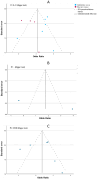Pancreaticobiliary Maljunction and Its Relationship with Biliary Cancer: An Updated and Comprehensive Systematic Review and Meta-Analysis on Behalf of TROGSS-The Robotic Global Surgical Society
- PMID: 39796748
- PMCID: PMC11719653
- DOI: 10.3390/cancers17010122
Pancreaticobiliary Maljunction and Its Relationship with Biliary Cancer: An Updated and Comprehensive Systematic Review and Meta-Analysis on Behalf of TROGSS-The Robotic Global Surgical Society
Abstract
Objective: This systematic review and meta-analysis aimed to determine the degree to which pancreaticobiliary maljunction (PBM) increases the risk of different types of biliary cancer (BC).
Methods: A systematic review and meta-analysis were carried out using the following databases: PubMed, Embase, Cochrane Library, Scopus, Web of Science, and Science Direct. We systematically searched from inception to April 2024. The search terms included were derived from the keywords "Pancreaticobiliary Maljunction" OR "Anomalous Pancreaticobiliary Junction" AND "Cancer" OR "Malignancy". Studies that provided data comparing BC rates in relation to PBM presence or vice versa were included. The Newcastle-Ottawa Scale (NOS) was used for quality assessment. The random-effects model was used.
Results: Fifteen studies were included with a total sample of 8604 patients, of whom 5015 (58.29%) were female with a mean age of 54.58 years. Patients with PBM had 8.42 (95% CI = 3.57-19.87) more risk of developing any type of BC, with a higher risk of GBC than BDC (OR = 16.91 vs. OR = 3.36, p-value = 0.003). There was a higher risk of having PBM in patients with GBC than BDC only when considering the Asian population (OR = 3.12, 95% CI = 1.09-8.94). Meta-regression analysis revealed that neither mean age (p = 0.087) nor percentage of female patients in the study population (p = 0.197) were statistically associated with the variations in OR for the risk of BC based on the presence of PBM.
Conclusions: There is a significant association between PBM and the risk of having BC, mainly GBC when compared to BDC. Most of the studies published reported data from Japanese patients, which limits the generalization of the results. The age of patients and sex were not significantly associated with the relation between PBM and BC. Further prospective studies in broader populations will provide additional details to take measures for screening and early management of PBM and BC.
Keywords: bile duct; biliary cancer; gallbladder; pancreatobiliary maljunction.
Conflict of interest statement
The authors declare no conflicts of interest.
Figures




References
-
- Mishra H., Radswiki T. Anomalous Pancreaticobiliary Junction. Radiopaedia; Cotham, VIC, Australia: 2010.
Publication types
LinkOut - more resources
Full Text Sources
Miscellaneous

